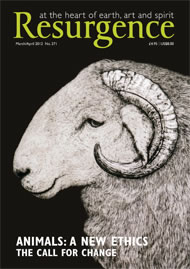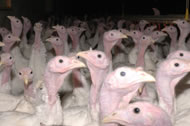The battery chicken
It is hell. Keith Mann, From Dusk ’til Dawn: “The smell...the accumulated festering waste of thousands of chickens piled high...below the cages...(in) peaks like the Alps...the pale feet of birds on wire above the compacted waste...thousands of rats. One looks down on a live bird fallen from a cage...no life left in her to complain...birds at every level of life, death and decomposition...caught in the deep pool of sodden waste, slowly rotting...”
She is one of 240 million in the EU. She begins laying at 18 to 20 weeks and will deliver some 300 eggs for a year before, calcium-deficient and brittle-boned, she’ll be killed as a ‘spent’ hen. (Left to live naturally she would reach 12 to 14 years.) She lives in a space smaller than an A4 sheet of paper with three or four others. She can’t move, stretch, preen, or spread her wings. Deprived of all natural functions, she may be painfully debeaked to stop aggression.
She stands on sloping wire mesh so that her eggs can roll down for collection and her faeces can fall through. Her cage is in a row in a stack in a shed. No daylight. No fresh air, but plenty of pesticide spray. Winter darkness is kept electrically. Light tricks her into unnatural and continuous laying. She might die from internal egg laying. She may be too weak to reach her antibiotic-laden food. And, as Professor Konrad Lorenz points out, “Public laying is torture to a hen.”
Having survived the broken-winged crush in the lorry, her diseased body will be hung upside down on the slaughterhouse conveyor belt, where she may be one of the annual millions who miss electrical stunning and go live into the scalding bath and the defeathering machine.
Her eggs sit in a box in the supermarket marked ‘farm-fresh’ with a picture of a happy chicken. Her chopped, cancerous body will be in baby-food stew or curry and in restaurants, daintily disguised.
Spain and Poland are currently defying new EU directives on better conditions for battery hens.
Cheap eggs?
The turkey
A miracle from The Jewish Vegetarian: “He bought a fresh-killed turkey...his wife plucked it leaving it in the kitchen before they went out... They returned home to find it huddled naked by the stove. Stunned rather than slaughtered, heat had revived it; its feathers re-grew and it became a family pet.”
His ancestors, native to the Americas, lived wild and free until Europeans got a taste for his flesh in the late 1800s. Selectively bred for unnaturally fast growth, constantly given hormones and antibiotics, he is prone to lameness and fatal heart disease.
As a male breeder, he suffers painful degeneration of the hips and other joints. Too heavy and broad-breasted (for more white meat) to mate, he undergoes the repeated stress of semen-milking. Females endure constant catching and insemination. The breeder must reach maturity in ‘good health’, so growth is slowed by severe food restriction, adding further stress from frustration and chronic hunger.
A day-old chick (poult) arrives from a breeding unit packed tightly in a box. Thrown into the shed, 5,000 out of 30,000 lives are considered expendable through rough handling.
Tiny birds in circular wire enclosures huddle close to a mother-substitute lamp, craving warmth. There are layers of them. Many suffocate. A weakness noticed means a broken neck and incineration.
Survival means being one of tens of thousands stranded on the increasingly wet and dirty litter floor. Foot sores and painful ulceration in a dingy, windowless shed – light creates excitement. Movement and rest are nigh impossible.
Death comes at two or three months. Broken wings and legs in tiered crates, stacked high on lorries. Forceful shackling onto a conveyor belt, head hanging down, flapping wings, panic – weight causing dislocations. He might miss the electrical stun. On to the neck-cutting. Conscious into the scalding bath.
Low-cost turkey twizzlers?
The dairy cow
From Farm Journal, Aberdeen: “He had sold a calf to another farmer...across the river. It was about 18 feet deep, with strong tidal currents. From her field the cow heard her calf calling to her. She broke through the fence, ran to the river and plunged in. Despite being swept downstream she managed to make it and eventually found the calf...”
Research shows that cows have a range of emotions – joy, fear, boredom, irritation and more. A cow will choose her herd friends. Intensive dairy production denies her cowhood. She’s a machine with no needs, tethered in a vast airless shed. Zero-grazing milk production is on the increase. She’ll find no security in having an established place in the herd hierarchy. She’ll have no relationship with a herdsman to lessen her anxiety – only the pressure for ever higher yields.
To produce milk, she must constantly be in calf. At 18 to 24 months a cycle of continuous pregnancies begins. She’ll lactate for 10 months, and six weeks after calving she will be artificially inseminated again. When her milk dries up, she’ll have only 6 to 8 weeks before calving again, during which she’ll be given a ‘steaming-up’ ration of concentrates. Her udder becomes hard and painful from too much milk. After three or four such heavy lactations her udder ligaments give, causing other problems.
Her calves are taken away at birth – the males, too young to cope with travel and handling, may be sent to Europe for veal, or shot. Females join their mother’s fate.
Her hormone-treated, infected udders give a milk that contains significant amounts of pus – and blood.
Soon spent, the terrors of the slaughterhouse await her after a stressful journey.
Traditional Sunday roast? Cheese – with rennet from the stomach of a newborn calf?
The breeding sow
As Matthew Scully points out in Dominion, “The treacheries begin on the day they are born. From the start they must feel they are in the hands of an enemy.”
Pigs rank next to, or above, dogs and three-year-old humans in intelligence. They learn quickly, build communal nests, which they keep very clean, live in extended families and are friendly.
Bred to be unnaturally large, for humans’ appetite for their flesh, 9 million go to slaughter annually in the UK alone, 250 million throughout the EU, and 1.3 billion worldwide.
Britain has half a million breeding sows, 60% of which are reared intensively indoors.
Sow-stalls, now prohibited in Britain, still prevail abroad, and imported pork and bacon from pigs kept in them is wrongly labelled ‘British’.
In a stall – a narrow metal crate on concrete – the sow can’t move, turn around or interact with others during her 16-week pregnancy. She’ll bite the metal bars as she becomes what scientists have labelled ‘clinically depressed’.
The farrowing crate for birthing is even more restrictive. During the three to four weeks before weaning, there’ll be skin lesions from the inevitable friction with metal and concrete; foot lesions; muscle weakness from no exercise; teat lesions and urinary infections.
Living naturally, she would spend 75% of her day foraging and exploring in a group.
Late in pregnancy, obesity can produce added health problems, so feed is restricted. She suffers from chronic hunger, frustration, stomach ulcers. Sufficient high-fibre, bulky food would remedy this, but the EU directive is often ignored.
A piglet machine, if she fails she’ll be culled. Her first sunlight is glimpsed on the way to the abattoir. She could live 10 to 12 years, but 1 or 2 years will see her out in this severe, intensive system. Her body can’t withstand its demands.
1% of pigs are bred organically in the UK, but they meet the same fate.
“What do you make of pigs?” asks a journalist.
“Absolutely bloody stupid,” replies the slaughterman.
“Why?”
“They’ve got a mind of their own.”
Dying for a bacon sarnie?








